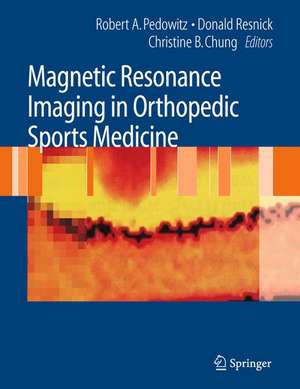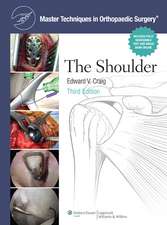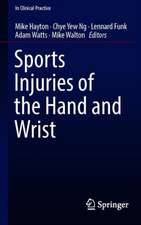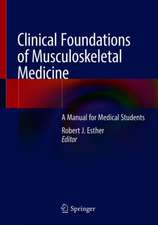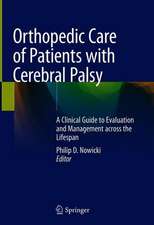Magnetic Resonance Imaging in Orthopedic Sports Medicine
Editat de Robert Pedowitz, Christine B. Chung, Donald Resnicken Limba Engleză Hardback – 6 oct 2008
| Toate formatele și edițiile | Preț | Express |
|---|---|---|
| Paperback (1) | 1118.38 lei 6-8 săpt. | |
| Springer – 29 oct 2010 | 1118.38 lei 6-8 săpt. | |
| Hardback (1) | 1335.77 lei 38-44 zile | |
| Springer – 6 oct 2008 | 1335.77 lei 38-44 zile |
Preț: 1335.77 lei
Preț vechi: 1406.08 lei
-5% Nou
255.60€ • 267.41$ • 212.33£
Carte tipărită la comandă
Livrare economică 29 martie-04 aprilie
Specificații
ISBN-10: 0387488979
Pagini: 439
Ilustrații: XIV, 439 p. 650 illus.
Dimensiuni: 210 x 279 x 23 mm
Greutate: 1.41 kg
Ediția:2008
Editura: Springer
Colecția Springer
Locul publicării:New York, NY, United States
Public țintă
Professional/practitionerCuprins
*Principles of MR Imaging: Clinical Indications, Imaging Technology *Shoulder: Normal Anatomy and Variations, Rotator Cuff, Labrum, Cartilage and Bone, Cysts, Plexus, Miscellaneous *Knee: Normal Anatomy and Variations, Ligament, Meniscus, Cartilage and Bone, Cysts, Periarticular, Miscellaneous *Spine: Cervical, Thoracic Lumbar *Elbow/Wrist/Hand *Hip *Ankle/Foot *General Issues: Tendonitis/Tendinosis/Tears
Recenzii
"This book does a remarkable job of bringing together orthopedic sports and MRI radiologic imaging experts to create a practical reference to assist sports medicine clinicians in interpreting common MR images related to sports injuries. … The book targets sports medicine clinicians … who make decisions based on MR images. … This is a must-read for orthopedic residents, radiology residents, sports medicine clinicians, and MRI radiologists who treat them." (Mark R. Hutchinson, Doody’s Review Services, January, 2009)
Textul de pe ultima copertă
Though magnetic resonance imaging has helped revolutionize the field of orthopedic medicine, a difference in perspective persists between radiology and orthopedic specialists. Magnetic Resonance Imaging in Orthopedic Sports Medicine is an interdisciplinary resource designed to bridge this gap. Radiologists will gain insight into why surgeons order particular imaging studies, and orthopedic surgeons will learn when to order an MRI and how to best interpret its results. An orthopedic expert and a radiology expert weigh in on every chapter to provide in-depth analysis of the spine, shoulder, elbow, wrist, hand, hip, knee, ankle and other topics. Each subject is further examined in case studies, algorithms, flow charts, anatomical illustrations and hundreds of sample MR images. Magnetic Resonance Imaging in Orthopedic Sports Medicine is the only reference that combines the specialized knowledge of radiologists and orthopedic sports medicine physicians to accomplish the goal of better patient care.
Caracteristici
Radiologists learn sports medicine terminology and why surgeons order imaging studies
Orthopedists learn when to order an MRI, how MRI affects clinical decision making, and how to interpret imaging studies
Descriere
This book grew from the commonsense notion that orthopedic surgeons and sports medicine clinicians need to und- stand the practical application and interpretation of magnetic resonance imaging (MRI) for the sake of their clinical pr- tices, while radiologists need broad clinical perspective in order to provide the best and most accurate MRI information upon which patient care decisions must be made. As obvious as that notion might be, relatively little emphasis was placed upon genuine, interdisciplinary MRI education for practicing doctors, especially at the early advent of MRI technology. This need is now much better recognized, evidenced by the growth of excellent lecture-based educational opportunities. Examples include interdisciplinary instructional courses taught by both radiologists and orthopedic surgeons at the Radiological Society of North America and the American Academy of Orthopaedic Surgeons over the last half decade. What has been missing from the educational landscape has been a focused, practical reference that would integrate the basic needs of radiologists and clinicians alike. This was the impetus for the current book, which has been an extra- dinary cooperative venture by authors who were asked to bridge that gap in a single resource: orthopedic surgeons and sports medicine specialists writing for the sake of their radiology colleagues, and radiologists writing for the benefit of their clinician partners.
